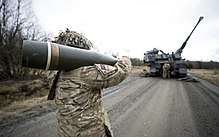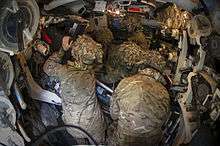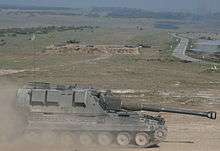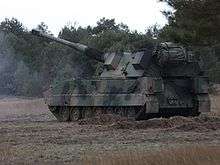AS-90
The AS-90 ("Artillery System for the 1990s"), known officially as Gun Equipment 155 mm L131, is an armoured self-propelled artillery weapon used by the British Army.
| AS-90 | |
|---|---|
| Type | Self-propelled artillery |
| Place of origin | United Kingdom |
| Service history | |
| Wars | Iraq War |
| Production history | |
| Manufacturer | Vickers Shipbuilding and Engineering |
| No. built | 179 |
| Specifications | |
| Mass | 45.0 long tons (45.7 t; 50.4 short tons) |
| Length | 9.07 m (29 ft 9 in) |
| Width | 3.5 m (11 ft 6 in) |
| Height | 2.49 m (8 ft 2 in) |
| Crew | 5 when moving (driver plus 4 gun detachment), full gun detachment 10 including driver, |
| Armour | max. 17 mm (0.66 in) steel |
Main armament | 155 mm L31 39 calibre gun (48 rounds) |
Secondary armament | 7.62 mm NATO L7 General Purpose Machine Gun |
| Engine | Cummins VTA903T V8 diesel engine 660 hp (493 kW) |
| Power/weight | 14.66 hp/t |
| Suspension | Hydropneumatic (Hydrogas) |
Operational range | 420 km (261 mi) on road |
| Maximum speed | 53 km/h (33 mph) |


History
AS-90 was designed and built by the Armaments division of Vickers Shipbuilding and Engineering (VSEL), whose parent company became BAE Systems in 1999. VSEL provided 179 vehicles between 1992 and 1995 at a cost of £300 million ($480 million). The AS-90 was first deployed by the British Army in 1993.[1] The AS-90s were acquired to re-equip six of the eight self-propelled field artillery regiments (each of 24 guns) in the I (BR) Corps, replacing the 105 mm FV433 Abbot SPG and older M109 155 mm Self Propelled Gun and FH70 towed howitzer.
In 1999, Marconi Electronic Systems was contracted to upgrade British Army AS-90s to include a 52 calibre gun in order to increase the range of the artillery.[2] Critical to the program was a bi-modular charge system from Somchem of South Africa (selected after extensive trials of ammunition from many suppliers), which offered greatly reduced barrel wear. However, this ammunition failed to meet the requirement for insensitive munitions and the project was terminated.[3]
It remains in UK service and will equip three field regiments supporting armoured infantry brigades for the foreseeable future. 134 were in service in 2008, reduced to 117 in 2015.[4] The AS-90 underwent a capability enhancement program in 2008 and 2009, primarily relating to upgrades of the AS-90's electronic system.
The initial expected out-of-service date for the AS-90 was 2030,[5] but this was later delayed to 2032, with its replacement planned to enter service in 2029.[6]
Development
AS-90 started in the mid-1980s as a private venture on the gamble that the tri-national SP70 would fail. When this subsequently occurred, the Ministry of Defence (MoD) issued a cardinal point specification on one page for a new 155mm self-propelled gun. Four tenders were submitted, and AS-90 was the only offer that was not "brochureware". The MoD was also required to consider the US "Paladin", an upgraded M109 howitzer.
The MoD has undertaken studies in 2006-09 to "up-gun" the Royal Navy's main shipboard gun armament, the 4.5 inch Mark 8 naval gun, to accept 155 mm ammunition from the AS-90.[7] This would introduce a common gun calibre for the British Army and Royal Navy, helping with ammunition logistics, and encouraging joint Army-Navy development of extended-range and precision-guided shells.[8] However, the Royal Navy did not implement this gun system.
Design
In 1963 certain NATO nations, including the UK, agreed a Ballistics Memorandum of Understanding for a 155 mm 39 calibre ordnance and a baseline projectile with the shape used for the US M549 rocket-assisted shell. The AS-90 uses a conforming 39 calibre barrel which fires the L15 unassisted projectile out to a range of 24.7 km. However, this was a new design of ordnance using a split sliding block breech with Crossley obturation, instead of the more usual screw breech, to permit bagged charges (no metal cartridge cases). The breech mechanism has a primer magazine holding 18 primers. The standard ammunition is that designed for FH-70 (L15 HE and associated propelling charges) although in training the less effective but cheaper M107 with Green and White propelling charges is used.
It is fitted with an auxiliary power unit to eliminate the need to run the main engine to keep the batteries charged while stationary; electrical servos drive the automated elevation, traverse, magazine, shell transfer arm and loader as well as power for electronics and communications.
The vehicle is fitted with an autonomous navigation and gun laying dynamic reference unit (DRU) mounted on the trunnion. All main turret functions are controlled by a Turret Control Computer (TCC) with control and display units for the No 1 (Detachment Commander), No 2 (loader) and No 3 (layer). The combination of the DRU, TCC and powered laying controls provide autolaying. Every gun is fitted with a radar Muzzle Velocity Measuring Device. Reversionary mode laying uses deflection laying via the direct fire sight.
The gun can be brought into action fully closed down, the barrel can be clamped and unclamped from within the vehicle. Into and out of action times are less than 1 minute.
Characteristics

- Crew: 5, on board when moving (driver plus 4 gun detachment), full gun detachment 10 including driver, 4 detachment members in the turret.
- Length: 9.07 m
- Width: 3.3 m
- Height: 3.0 m
- Armour: 17 mm (maximum, steel)
- Weight: 45 tons
- Calibre: 155 mm
- Range: 25 km (39 cal), 30 km (52 cal) standard charges
- Rate of fire: 3 rounds in 10 seconds (burst), 6 rounds per minute for 3 minutes (intense), 2 rounds per minute for 60 minutes (sustained)
- Secondary armament: 7.62 mm L7 GPMG
- Ammunition carried: 48 projectiles and charges (31 turret and 17 hull), 1000 MG rounds
- Main Engine: Cummins VTA903T 660 bhp 90 degree, v8, 4 stroke, liquid cooled, turbo diesel,
- Max Speed: 55 km/h (Road)
- Range: 370 km or 231 mi (Road)
- Ground clearance: 0.41 m; Gradient: 60°; Vertical obstacle: 0.75 m; Trench crossing: 2.8 m; Fording depth: 1.5 m
Variants

AS-90D - Modified for desert use. Thermal protection for crew and extra cooling for engine and machinery. Tracks adapted for reduced wear in sandy conditions.
AS-90 "Braveheart" - Basically the AS-90, but fitted with the 52 calibre length gun. This project was terminated due to non-compliant propellant charges.
Armatohaubica "Krab" - (eng. Cannon-howitzer Crab) Licensed "Braveheart" turret on a K9 Thunder chassis, with modern "Azalia" BMS. Designed and integrated in Poland, by Huta Stalowa Wola and WB Electronics. Two Krab ("Crab") prototypes were built in 2001, and successfully completed all required evaluations and state acceptance trials. Initial serial production started in 2008, with eight units delivered to Polish Land Forces for testing.[9] In 2014 production of Krab chassis was forwarded to Korean Samsung Techwin, which will provide 120 units, replacing Polish build UPG chassis in serial vehicles.[10]
Operators
- British Army - Royal Artillery
See also
- Panzerhaubitze 2000, German 155mm artillery from Rheinmetall in service since 1998
- M109 howitzer
- Type 99 155 mm self-propelled howitzer
- AHS Krab - the Polish variant using the AS-90 turret
- G6 howitzer - A South African 155mm self-propelled howitzer from Denel land systems
References
| Wikimedia Commons has media related to AS 90. |
- Additional deployment information Deagel.com
- "AS90 Howitzer (Hansard, 9 June 1999)". Retrieved 28 December 2016.
- "AS90 Braveheart 155mm Self-Propelled Howitzer". Retrieved 28 December 2016.
- UK Ministry of Defence, ed. (23 April 2015), Vehicle & Aircraft Holdings within the scope of the Conventional Armed Forces in Europe Treaty Annual (PDF) (2015 ed.), p. 4.
- Quin, Jeremy (9 March 2020). "Artillery: Decommissioning:Written question - 24276". UK Parliament. Retrieved 10 March 2020.
- British Army’s AS90 howitzers to stick around amid replacement delay. Defense News. 30 July 2020.
- 155MM Study Looks To Pack More Punch Into The Royal Navy's Fleet Archived 12 February 2012 at the Wayback Machine BAe Systems Press release, 14 December 2007
- Army to get new precision "search and destroy" anti-armour weapon Archived 11 December 2007 at the Wayback Machine MoD Press release, 20 November 2007
- "Kraby dla 11. MPA - Altair Agencja Lotnicza". Retrieved 28 December 2016.
- Samsung Techwin signs deal for delivering 120 K9 Thunder self-propelled howitzers to Poland. armyrecognition.com, 17 December 2014.
- "1st Regiment Royal Horse Artillery". British Army. Retrieved 4 August 2015.
- "The Scottish Gunners". British Army. Retrieved 4 August 2015.